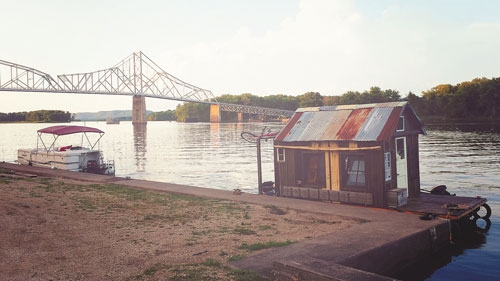You are here
Home ›Artist seeking stories of river history and lifestyles makes stops in Lansing, Harpers Ferry on shantyboat tour

The shantyboat pictured at right above docked at Lansing's riverfront has been making its way down the Upper Mississippi River and made a three-day stop in Lansing early last week and a more brief stop in Harpers Ferry about mid-week. On board are Santa Cruz, CA artist Wes Modes and his crew, who are working to compile a project entitled "A Secret History of American River People" and are seeking to talk to area residents about their history, experiences and lifestyle in a river community. Modes and his crew interviewed Lansing resident Karen Galema and former clammer Terry Sykes of DeSoto, WI and also enjoyed some of the Lansing hospitality with visits to such places as Horsfall's Lansing Variety Store, Welsh's Village Farm and Home and Shep's Riverside Bar & Grill. Submitted photo.
A rustic recreated 1940s shantyboat, a daring river voyage, and a meticulous archive of river stories are all part of a multi-year art and history project being undertaken by artist Wes Modes of Santa Cruz, CA and entitled "A Secret History of American River People."
Modes set sail last summer on the Mississippi River to collect the stories of people who live and work on the river from the deck of his homemade houseboat (seen in the photo accompanying this article). This year, he and his crew (and dog) started near La Crosse, WI, where he left off last September and are slowly making their way downriver.
As part of his trek down the mighty Mississippi last week, Modes and his shantyboat crew stopped in Lansing for several days in the early part of the week, and also made a brief stop in Harpers Ferry about mid-week. As the focus of his project, the artist was looking for residents who recall the history of river communities to tell their stories in interviews. He also invited residents to come see the shantyboat.
"We had the honor to interview Karen Galema, who co-manages the River History Museum," Modes said of his time spent in Lansing. "She related her experience growing up along the river, as a fisherman, and working at the historic fish market in Lansing."
A portion of Galema's interview can be found on the project website at http://peoplesriverhistory.us in the blog section of the website. Additional photos and videos of the "Secret History of American River People" trek can also be found at that same website location.
"We were in Lansing for several days, so we fell in love with Horsfall's Lansing Variety and Welsh's Village Farm and Home," Modes said. "They were all sweet to my dog, Hazel, who fell in love with them. The people at Shep's (Riverside Bar & Grill on the Lansing riverfront) were hospitable and curious about our expedition and asked us lots of questions. We even met people we knew from last year's expedition while having dinner at Shep's."
Modes said the crew also interviewed Terry Sykes from DeSoto, WI, who was an old-time clammer and now runs a greenhouse business. "He told me about life on the river and scrambling to make a buck and survive," Modes relayed. "He also took us out along the river and in the backchannels, where we saw dozens of bald eagles, adults and adolescents. A real treat."
"The Secret History of American River People" got its start last summer when Modes set out on a journey in his homemade shantyboat on the Upper Mississippi River to gather the lost narratives of people who live and work on the river. Inspired by historical accounts of shantyboaters on the Ohio and Mississippi rivers, he floated Huck Finn-style for a summer, listening to and recording the stories of those he met.
The project hopes to encourage an awareness of the issues facing current river communities, the long history of people who have lived on and adjacent to the river, and an understanding of river ecology. The project is also an effort to connect individuals and communities that live along the river with those far from it.
At exhibitions held earlier this summer in the Twin Cities in Minnesota, the project featured a touring participatory installation, an interactive web documentary, and a research archive. Visitors can step onto the recreated shantyboat, pick up the banjo or a book from the library, sit awhile and overhear the hidden stories of shantyboaters, scientists, historians, and locals who live and work on the river. The web documentary allows visitors to experience the journey and get to know its subjects from afar. The research archive makes available these stories to future generations of scholars.
The journey and the project are detailed in the project website at http://peoplesriverhistory.us/. Modes' progress can also be followed through a blog and other social media venues at that same website address. Anyone wishing to further correspond with Modes in regard to his project can also find his contact information on that same website.

